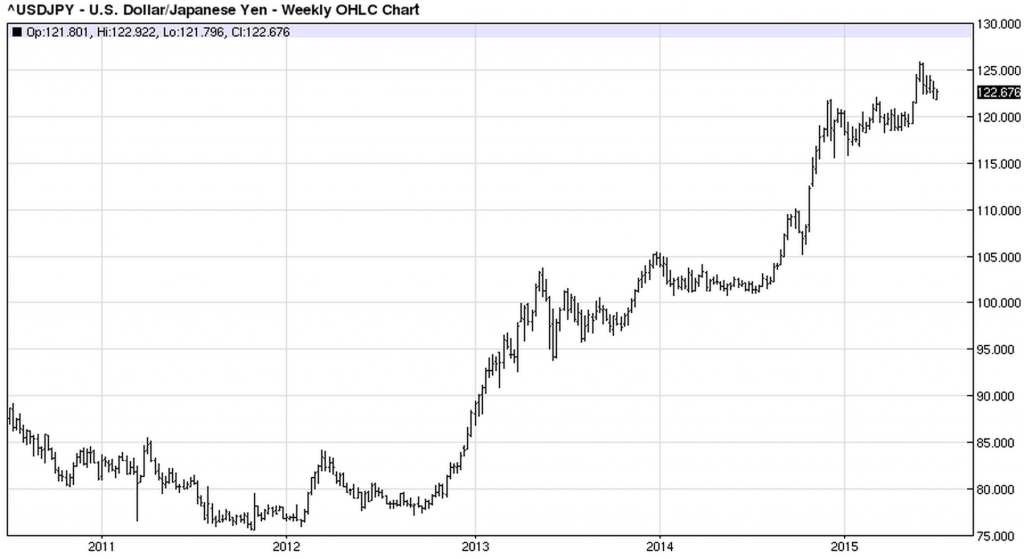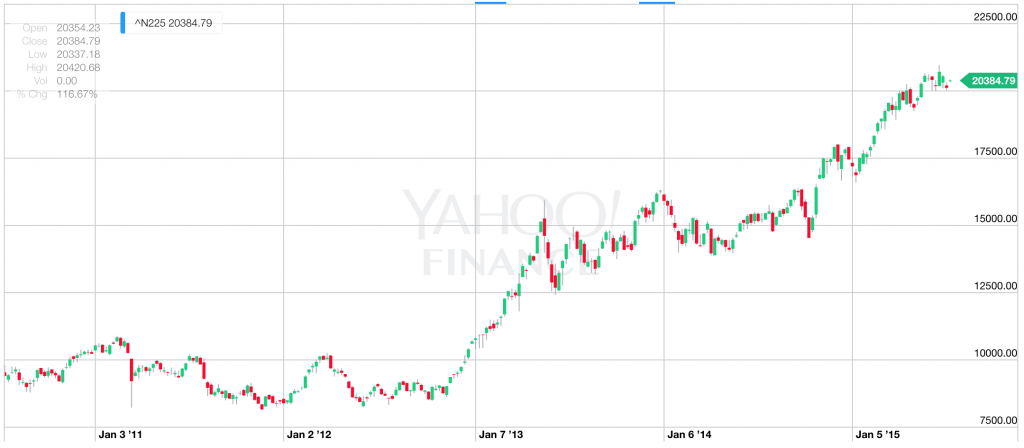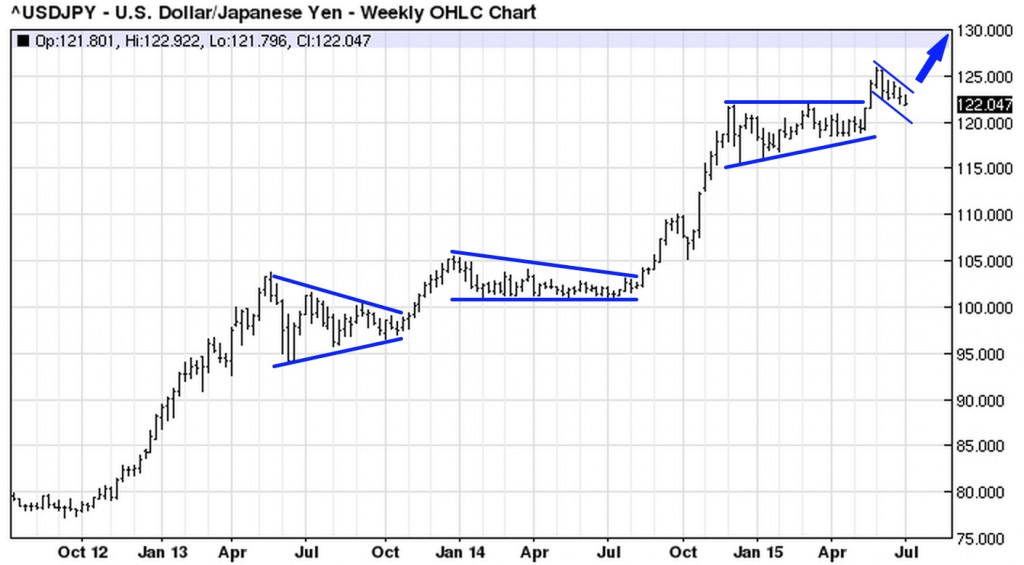In the prior three parts to this series, we explained that Japan has a demographic problem (part 1), a debt problem (part 2), and that the two are likely to collide in the coming years (part 3) when Japan eventually is faced with higher interest rates.1<- – – Click this little footnote.
So to close out the series we’ll take a look at what happens next and how one might trade this theme if one were so inclined.2
The Eventual Rise in Japan’s Interest Rates
In part three we discussed the fact that Japan’s record debt load of 226% of GDP has so far been manageable due to record low interest rates. Over 95% of Japan’s sovereign debt is owned by the Japanese,3 but with Japan’s population aging and more of its citizens moving from the workforce to retirement, they will become net spenders rather than savers and the Japanese government will not be able to rely on them to buy all of the newly issued debt that is needed to fund the government’s operations.4
When Japan is forced to look to the capital markets to fund the deficit, it will come under the same scrutiny as other heavily indebted nations (i.e. Greece). Investors are almost certain to require a higher interest rate to compensate for the increased risk of loaning to highly indebted Japan. When that happens, Japan’s budget deficit will get even worse and the government will have to spend even more of tax revenue on interest payments. So what will it do?
Japan Will Have To Print Money
When the going gets tough, governments print money. It’s just what they do. But what exactly is “printing money?” That phrase is used in the financial media all the time5 but what does it actually mean?
It’s basically when a government creates new money out of thin air by having its central bank buy up bonds. “Quantitative easing” is another official name, but those that don’t like the policy also call it “debt monetization.”6
“Printing money” previously carried a very negative stigma, but that was before the 2008 financial crisis. In response to the crisis, many of the world’s central banks have used creative policies to inject liquidity into the system, policies which are basically the same thing as printing money. And for over five years the goldbugs7 have warned that 1) central banks will kill the system by creating massive inflation and 2) that gold will to to $20,000.8 Neither happened so now banks are less nervous about “quantitative easing” (i.e. printing money) and are generally glad they did it.
But the risk is that QE or “printing money” or “debt monetization” is a dangerous slippery slope. If you start QE to fight a crisis… it isn’t long before the government figures out that it’s easier to run deficits when you have a powerful central bank buying your debt. Governments would much rather have a friendly central bank buying their debt than international creditors – who can have lot of demands as Greece is finding out the hard way. So if a government can get away with monetizing debt… it will.
The “How To” On Monetizing Government Debt
Let’s say that the government runs a deficit of $100 billion, meaning it has expenses of $100B more than its tax revenue. It probably won’t want to raise taxes or cut expenses – that makes voters angry. And rather than going to the international capital markets and issuing $100B of bonds to plug that deficit,9 the government looks across the table10 at its friend the central bank and goes wink wink. The central bank11 then buys $100B of bonds directly from the government to plug the $100B hole.
That $100B has now effectively been created out of thin air so you have increased the money supply (or “created liquidity”) by $100B. The government also now has the $100B it needs to operate and the central bank is the proud owner of $100B in bonds. So the government didn’t have to raise taxes, cut spending, or go to the open market to sell bonds, and kinda-sorta owes the money to itself.12 Well, it sounds like everyone wins, so what’s wrong with that?
Well… here’s where the goldbugs come back into play.13 Typically printing money is a bad thing. If you just randomly increase the money supply, everyone’s going that take that new money in the system that you have created and run out and buy things with it, which we all recall from economics 101 causes inflation and drives up prices.14
So that’s where the goldbugs get their “the Fed is going to kill us all” inflation fear. But since 2008… much of that newly printed money that the world’s central banks are issuing isn’t making its way through the system and ending up at Walmart. The banks are getting new liquidity from the various QE programs, but much of that newly created cash is just parked on deposit at the Fed or in banks. There really hasn’t been a strong increase in demand, spending, etc from the increased money supply and inflation has been low to non-existent.
And since inflation hasn’t really been a problem as a result of all of the printing, QE, debt monetization, or whatever you want to call it… central banks have become less afraid of it.15 You probably hear more about what the Fed is doing than any other central bank, but many of the world’s top economies are doing something similar.16
Well, one country is winning the printing game. Japan has been doing a bigger version of quantitive easing than the world’s other central banks. Not bigger in terms of total dollars or yen, because our economy is much bigger than theirs,17 but as a percent of the economy or a percent of the government’s operations, whichever way you prefer to look at it. This is all part of “Abenomics” as the government tries to claw the Japanese economy out of a 20 year funk and escape deflation. To do so, Japan is hoping that a little18 money printing will create inflation of 2%.19
Now That Japan Has Started Monetizing Debt, It Will Be Hard To Stop
So for now Japan is printing money to try and jump-start inflation, demand, and the economy. It really wants that 2% inflation target to be hit. But this is one of those “be careful what you wish for” moments.
Recall that now Japan has almost no inflation, which is another reason bond yields can be so low. If interest rates are 0.5% and inflation is 0%, then you are “earning” 0.5% interest. But if inflation goes up to 2% and bond yields stay at 0.5%, then you are losing money because over time as you are earning interest payments that inflation is cutting into your gains (i.e. your future dollars are worth less because prices will be higher).
Now that Japan is doing QE to try and boost inflation, it might not be able to stop.
Ever.
Recall that in part 3 we noted that the Government Pension Fund has already started to reduce its purchase of Japanese Government Bonds (JGBs) as it shifts to equities to boost returns. Well, at the same time the Bank of Japan (“BoJ”) stepped in to offset them as a buyer because of the QE program, so the effect of reduced JGB purchases by the pension fund has not been felt. But if Japan hits that 2% inflation target and the BoJ wants to stop buying JGBs… the Pension Fund isn’t likely to pick up the slack. And that is the scenario I’ve been trying to paint with this post.20
If the BoJ doesn’t keep up it’s buying of bonds… Japan will have to go to the international markets – which will demand higher interest rates, push up interest payments, and cause a major fiscal crisis. So the BoJ just might be stuck buying bonds and monetizing the debt for a very21 long time.
But Markets Look Forward, Not Backward
So, what happens when a government monetizes debt? Usually it weakens the currency.22 So if the Bank of Japan is going to be printing money for a long time as part of QE, and it won’t be able to stop monetizing debt when the JGB buyers go away… what can one do to profit from a weakening yen?
Well, the thing is… the smart money is already in this trade. When you have a not-so-secret problem that everyone is talking about – i.e. that Japan has too much debt, the Bank of Japan is already doing its own form of quantitative easing to boost liquidity and try to create inflation, and even the Prime Minister speaks publicly about weakening the Yen as a boost to the Japanese economy, the markets cannot be expected to sit around on their hands to wait for it to happen.
The Yen started weakening in late 2012 and hasn’t looked back since:

Note: the Yen is the base currency in this chart, so as the chart goes higher from left to right that’s the US Dollar gaining on the Yen (and of course the Yen weakening against the dollar).
So since Abenomics and QE started ramping up in 2012, the Yen has weakened from 80 Yen to the Dollar to 125 to the Dollar.23
Typically speaking, a weak currency is good for export-driving economies.24 Think of it this way… if Toyota sells a car in the US for $30,000 and brings that $30,000 back to Japan in 2012 at the old Yen rate of 80 to the dollar, Toyota would get 2,400,000 Yen after the conversion.25 Today if it sells the same $30,000 car and bring that back to Japan at the new weaker Yen rate of 125, it would get 3,750,000 Yen.26 That “extra” 1,350,000 Yen is basically an FX profit in the company’s operating results.
Or… rather than getting that FX profit Toyota could just lower it’s price to compete with Mercedes, GM, or whoever. Because the Yen is weaker, it would still be bringing home the same amount of Yen.27 When the Yen started to weaken in late 2012, many of Japan’s corporations began raising their profit forecasts because of the windfall that comes from repatriating those profits into a weakening currency. So a weak currency = good for exporters.
Knowing that the weakening Yen should/could/would be good for stocks, when the Yen began to weakened in 2012, Japan’s benchmark Nikkei index took off as well:

As you can see, the chart of the Dollar/Yen and this chart of the Nikkei are almost perfectly correlated.
The Japanese stock markets, like those in the US, Europe, etc, are already way up.28 Investors have been backing the idea that the Yen will continue to weaken, exporters will benefit, the Japanese economy will finally escape the lost decades, and all will end well.
The Best Trade… Might Be Patience
Sometimes the best trade is sitting on your hands. There are a few different ways that we hope to play the eventually slow motion train wreck that will be the Japan debt crisis. We just won’t be jumping to do it with an aggressive bet any time soon. We’d prefer to just dip our feet in the water first to test the temp.
The first option is just to directly play a weakening Yen in the FX market. We are already short Yen, but I have no illusion that we’ll profit immediately – it might be frustrating along the way with a lot of bouncing around, and the trade will require a lot of patience.
The trend the past few years as been for the Yen to weaken, then consolidate for a few months, then weaken more, then consolidate again. Rinse. Repeat. We’re hoping this current move is the same process and of course selfishly we want to see the pair break higher still (i.e. the Yen to weaken):

We are hopeful that 130 Yen/Dollar is one BoJ or Fed comment away. But… the Yen has already weakened a lot and other than a few months here and there over the past few years when global markets have fallen in “risk-off” mode,29 it’s been a one way move weaker. I’d love to think the Yen just keeps going, but we may have to take several shots at this one. Should we get a few months of really bad market turmoil,30 any correction by the Yen could actually be healthy since it has weakened so quickly. On a longer time frame though, as wild as it sounds now, we expect to see 200 Yen/Dollar again,31 and perhaps even 300 way down the road.
If playing a weakening Yen directly in the FX market is one option, the second option is to buy Japanese equities, and this trade looks much like the Yen as we showed in the charts above.32 The “long Japanese equities” trade has already gone so far, but corrections will be a good thing and a buying opportunity. There will be plenty of opportunities to buy both the broad Japanese market and to cherry pick for specific companies that will benefit for a weakening Yen when valuations are attractive.
Should my new fund find success and grow, there are plenty of other options that will be on the table as well. Right now we are too small so I can’t exactly pick up the phone and call a CDS33 desk at Goldman, but if I could I’m sure there are plenty of heavily indebted Japanese companies that will be very sensitive to any eventual rate increase for which I’d like to buy some credit protection.34 As a currency nerd, I often find myself going back to interest rates and thinking of trades and investments in those terms,35 but there will be plenty of other macro trades as well that will show up as this theme starts showing up on the front page of the financial media.
Summing It All Up
So. This is going to be a slow motion theme but I strongly feel it will be one of the most important challenges to the global markets. Eventually.
Perhaps the most critically important part of playing this out will be not locking oneself into a “timed” trade. Buying an option or placing a similar trade where you have to be proven correct in X number of days, weeks, or months has continued to be a losing trade when it comes to a Japanese debt crisis.
At the macro level, we are currently short the Yen and hope to continue to be for some time. This might be slow, but it’s not going to be boring.
Thanks for reading,
Christopher
These little boxes are where I try to explain something in more detail in case it’s new to the reader. Or… other times I’ll just try to make a funny comment.↩
I’ll also try to go back to saying “I” because one shouldn’t refer to one’s self as “one” so often. Way too early in the post for that. Moving on.↩
Specifically by retirees, banks and investment funds, and the Government Pension Investment Fund.↩
…which run a deficit because tax revenue is lower than government expenditures.↩
Usually not politely. And often by some wacky, wiry-haired investment manager who’s screaming for you to buy gold.↩
Monetizing debt is seen as a bad thing. If the government is running a deficit, it should fix the deficit by spending less or raising taxes. It shouldn’t just print the money to plug the hole. More on that in a future post. Probably.↩
“Goldbug” is a phrase the rest of us use to describe investors who are obsessed with owning gold. Their strategy is basically “Markets up? Inflation is coming so buy gold.” or “Markets down? Banks will print money and inflation is coming so buy gold.”↩
…Or whatever crazy number they are spouting these days.↩
…At an interest rate determined by the market – which might be unfavorable.↩
Probably a very expensive mahogany table.↩
i.e. the Fed, Bank of England, Bank of Japan, etc↩
…or rather to its nephew the central bank↩
Probably not quietly, but rather screaming “don’t tread on me” and telling you to buy gold instead of holding “worthless” paper money because the world is ending. If you can’t tell, I’m not a fan of the goldbug way of thinking. If the world is ending I want to be invested in bottled water, bullets, and something I can practically trade like spam and cows. Not a heavy gold bar worth $250,000. Good luck trading that for a chicken. Ok, now I’m way off topic.↩
Next thing you know people are taking wheelbarrows full of worthless paper notes to buy a loaf of bread. Or so the thinking goes…↩
When the Fed announced the first QE program, the dollar tanked and gold and other precious metals shot higher because everyone feared inflation. But it didn’t happen. And subsequent QEs had a very “meh” effect.↩
Actually if you don’t follow currencies or other specific global markets you probably don’t hear about it at all.↩
‘Murica!↩
ok, a lot of↩
Central banks are WAY more scared of deflation that inflation. As the thinking goes… if you start having inflation problems that’s an easier battle to fight. You just jack up interest rates until the economy slows and inflation comes down. But deflation is often a demand problem. You can’t make people spend money, so they are all terrified of deflation. And Japan has been stuck in a deflation spiral for 20 years.↩
This long… rambling… wow he really is a currency nerd post.↩
very↩
Generally speaking, printing money will weaken your currency. There are some exceptions – i.e. how the Swiss National Bank has been trying, unsuccessfully, to stop the Swiss Franc from appreciating – but it’s generally the rule. It’s very hard to strengthen your currency artificially, but in theory if you want to weaken it you can print money into oblivion and get that effect. Moving on.↩
i.e. if you exchanged $1.00 in 2012 they’d hand you 80 Yen. Today they would hand you 125 Yen. Which was awesome for our trip to Japan↩
…like Japan, Germany, China, etc↩
$30,000 x 80 = 2,400,000 Yen.↩
$30,000 x 125 = 3,750,000 Yen↩
I’ve WAY oversimplified that for purposes of this article. It’s more complicated than that because that car might have been made at a plant in the US and Toyota has a great many expenses/costs outside of Japan so it doesn’t really bring all $30,000 home. But it’ll work for this article’s purpose.↩
Although in the case of Japan… still WAY below the bubble peak from the 80s.↩
during these mini-panics, “risk” assets such as stocks sell off and investors move to perceived safer places such as bonds ↩
from Greece, China’s sell off, or any other source↩
1986 was the last time the Yen was over 200 to the dollar↩
i.e. both go higher “from left to right” on the chart.↩
“Credit Default Swap.” Yes, those things.↩
So if there’s a Goldman banker reading this that wants to clear for a tiny fund with less capital under management than you probably got as a bonus last year… then kindly give me a call.↩
i.e. who will benefit and who will lose if/when rates go up. Then you buy those that benefit and sell those that lose.↩


Comments 2
Nice. Best Japanese conclusion since Karate Kid 2.
Author
Thanks. I try to blog “very nice… like Geisha…” <--- hope that quote from the bad guy is correct.